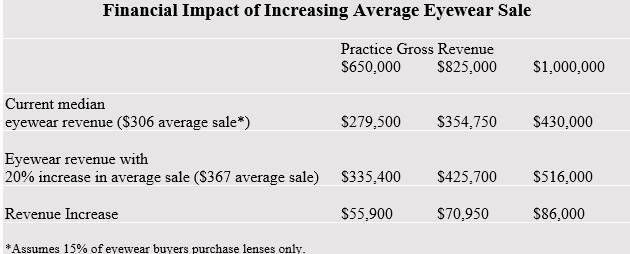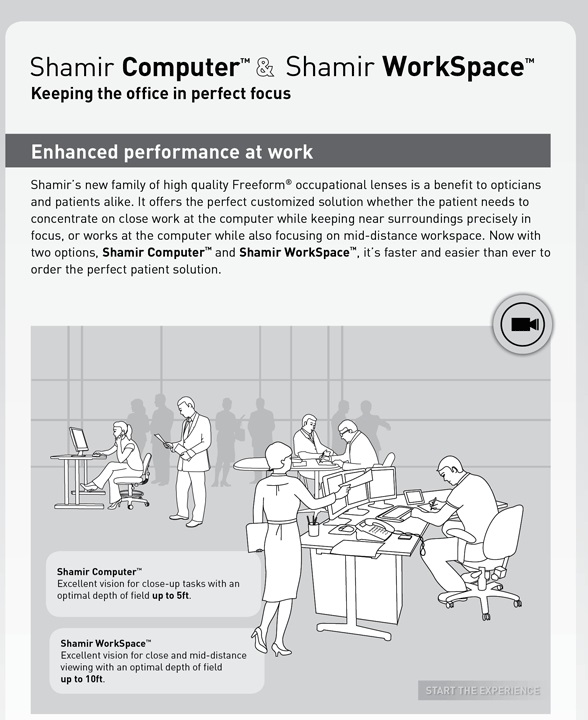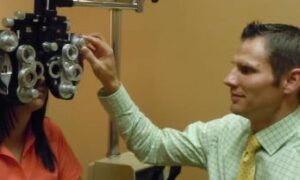By Thomas F. Steiner,
Director of Market Research
Review of Optometric Business
Feb. 22, 2017
The best managed independent eyecare practices continuously update a priority list of process improvement projects that challenge the status quo and complacency, and have potential to significantly improve financial results.
The best process to set improvement priorities is to quantify the upside of each initiative. When potential return of a range of projects is quantified, many practices find that the improvement goal with the greatest upside is to increase the average sale to eyewear buyers. This is true because:
DRIVE REVENUES. Eyewear is the dominant revenue producer in most practices, accounting for a median of 43 percent of gross revenue among independent ODs. In a practice grossing $650,000 annually, eyewear sales typically total $279,500, yielding a gross profit of $170,495. No other business initiative has as much financial upside.
MOST PATIENTS WEAR GLASSES. Some 85-90 percent of patients in typical independent practices wear eyeglasses, and nearly all are potential eyewear customers. Upgrading the eyewear product mix can impact nearly every patient.
NO ADDITIONAL INVESTMENT NEEDED. Upgrading the average eyewear sale usually requires little or no financial investment.
OPTIMIZE & BETTER COMPETE. Most independent ECPs have not yet optimized their eyewear product mix, and have sizeable potential to increase their average sale. There is a wide range in the average eyewear sale among independents, which is not explained by differences in patient demographics. According to data from the Management & Business Academy, the 10 percent of practices with the highest average eyewear sale realize revenue per pair 70 percent higher than the median practice, while practices in the bottom 20 percent realize an average eyewear sale 35 percent below the median. Most practices have an opportunity to improve their average eyewear sale by 20 percent or more with a focused effort.
Apart from the immediate financial benefits of improving the sales mix, providing patients with superior eyewear solutions increases satisfaction and loyalty. A practice which offers patients the latest technology enhances its reputation among patients, and often reduces the interval between eyewear purchases.
Based on 2016 VisionWatch data from The Vision Council, it is estimated that the average eyewear sale per pair among independent ECPs is currently $306. Increasing the average by 20 percent results in substantial revenue and gross profit gains.

The Vision Council’s VisionWatch consumer surveys show that ophthalmic lenses account for 57 percent of total eyewear sales revenue among independent ECPs. Upgrading the average lens sale should be a high priority practice improvement goal.
A closely related opportunity for independents is to increase the number of multiple pair eyewear sales. Currently it is estimated that just 10 percent of patients of independent ECPs buy more than one pair of glasses when making an eyewear purchase. VisionWatch surveys show that 63 percent of adult eyeglass wearers use a single pair of glasses. This means that a majority of patients fail to optimize their vision in different lighting conditions or for specific vision tasks. It’s ironic that people typically own 10, or more, pairs of shoes, for use in different occasions and activities, but settle for a single pair of glasses for every situation. It’s not that people cannot afford more than a single pair of eyeglasses, but that the benefits of multiple pairs have not been conveyed.
Computer Lens Opportunity
Increasing computer lens dispensing is among the larger opportunities ECPs currently have to increase the average eyewear sale and multiple pair sales. Computer lenses address unmet needs of a large segment of the population, which is not aware of the benefits. The lens type is under-utilized today in most practices and yields above average revenue per pair.
Consider these facts:
DIGITAL DEVICE USE INCREASING. Usage of digital devices has become both universal and frequent among adults. More than two thirds of adults use smartphones daily, and penetration continues to grow. A large majority use a computer daily. Four-in-10 adults use a tablet or e-reader daily. Currently, the Bureau of Labor Statistics estimates that half of all occupations require regular computer use. In the future, more and more occupations will require frequent daily use of digital devices.

REDUCE DISCOMFORT. Usage of digital devices causes discomfort and vision problems among 65 percent of adults, according to a 2016 Vision Council report on Digital Eye Strain. These symptoms can be alleviated by corrective devices designed to optimize comfort and acuity as these digital vision tasks are performed.

Penetration of computer lenses is low among eyewear buyers. In 2014 a Vision Council survey indicated that just 8 percent of adult eyeglass wearers used any computer lenses.
EDUCATE PATIENTS. Awareness of computer lenses is also low among eyeglass wearers. The Vision Council survey cited above indicated that 52 percent of wearers were not aware of this lens type, and 45 percent said they had not purchased computer glasses because they were not aware of them. Other Vision Council surveys indicate that there is little consumer understanding of how computer lenses work, or of the benefits they provide, but there is a readiness to try such lenses.
MAXIMIZE GROWTH OPPORTUNITY. MBA data indicate that computer lenses account for no more than 5 percent of eyewear Rxes. Thus, there is a large upside potential to increase usage of computer lenses as a second pair.
Getting Started with a Computer Lens Initiative
Educate staff about computer lenses
To present computer lenses effectively, staff must be knowledgeable about the features and benefits of these products. Continuing education seminars and presentations by lens sales reps can be helpful. The technology is evolving rapidly, so it is important to keep up-to-date.
Set goals and track progress
Determine the current revenue contribution of computer lenses to overall eyewear sales, then set quarterly goals for the next 12 months and share with your staff. At least monthly, share performance results and discuss with staff.
Uncover digital device usage of each patient
The extent of a patient’s usage of digital devices has become an important definer of a patient’s daily vision environment. Every patient should be asked how many hours a day they use a desktop or laptop computer, tablet or smartphone. Any patient who uses a digital device for four, or more, hours daily could potentially benefit from computer lenses.
Develop scripts for patient education
Many patients do not understand how a computer lens could offer superior acuity and comfort. To ensure consistent communication, it’s best to use standard, benefit-oriented messages about computer lenses, that avoid jargon and technical detail. The scripts provide a foundation that individual staff members can use to craft their own presentations about computer lenses.
Feature computer lenses on the practice web site and in marketing communications
Many patients are not aware of computer lenses, yet suffer through the symptoms of digital eye strain. Once aware of this lens type, many will be interested in trying computer lenses. All of the communication vehicles used by the practice can educate patients about computer lenses.
Keep the Office in Focus
 Thomas F. Steiner, Director of Market Research for ROB, has spent more than 25 years helping eyecare practices succeed, including pioneering the introduction of color contact lenses into optometry. To contact him: tom.steiner@cibavision.com
Thomas F. Steiner, Director of Market Research for ROB, has spent more than 25 years helping eyecare practices succeed, including pioneering the introduction of color contact lenses into optometry. To contact him: tom.steiner@cibavision.com




























